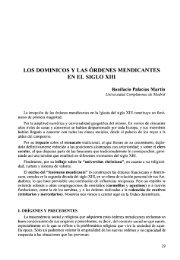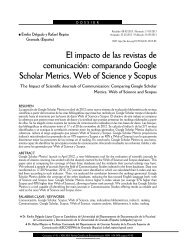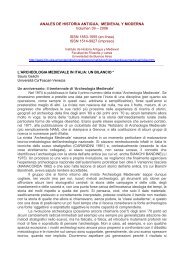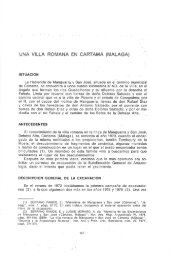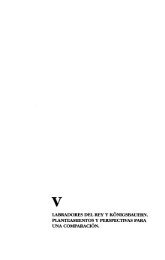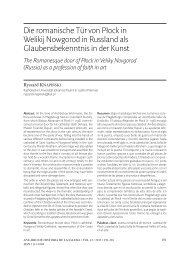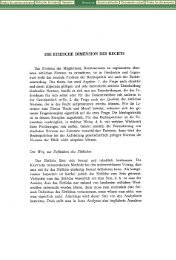Roslyn M. Frank 1.0. Introduction In the first chapter of this ... - Dialnet
Roslyn M. Frank 1.0. Introduction In the first chapter of this ... - Dialnet
Roslyn M. Frank 1.0. Introduction In the first chapter of this ... - Dialnet
You also want an ePaper? Increase the reach of your titles
YUMPU automatically turns print PDFs into web optimized ePapers that Google loves.
104 <strong>Roslyn</strong> M. <strong>Frank</strong><br />
lems with which <strong>the</strong>y are confronted. As a result, researchers working within<br />
<strong>this</strong> framework have come toge<strong>the</strong>r from a variety <strong>of</strong> fields, e.g., genetics,<br />
especially molecular evolutionary genetics, geography and more recently<br />
phylogeography, evolutionary and population biology and ecology, evolutionary<br />
psychology, archaeology and its subfield <strong>of</strong> cognitive archaeology.<br />
However, until now <strong>the</strong> fields <strong>of</strong> historical linguistics and ethnography have<br />
not been brought into play in support <strong>of</strong> <strong>the</strong> PCRT narrative. That is, so far<br />
evidence from <strong>the</strong>se fields has not been applied directly on <strong>the</strong> PCRT model<br />
in order to validate its central hypo<strong>the</strong>sis concerning early population expansions<br />
out <strong>of</strong> <strong>the</strong> Pyrenean-Cantabrian refugium. Consequently, given that<br />
<strong>the</strong> ursine cosmology under discussion here could date back to a Mesolithic<br />
mindset, a careful analysis <strong>of</strong> <strong>the</strong> distribution <strong>of</strong> artifacts relating to it – both<br />
linguistic and ethnographic in nature – could become an additional mechanism<br />
for charting postglacial colonization routes emanating out <strong>of</strong> <strong>the</strong> proposed<br />
Pyrenean-Cantabrian zone.<br />
Hence, <strong>the</strong> task <strong>of</strong> identifying and documenting <strong>the</strong> locations where ursine<br />
performance art and associated beliefs have survived is particularly important<br />
especially in <strong>the</strong> case <strong>of</strong> <strong>the</strong> more elaborate forms <strong>of</strong> such performances<br />
encountered in <strong>the</strong> Pyrenean-Cantabrian zone and locations immediately adjacent<br />
to it, e.g., zones in which Catalan is spoken today. Fur<strong>the</strong>rmore, <strong>the</strong><br />
cultural artifacts under study can also be compared to those found in Sardinia<br />
which is <strong>the</strong> second genetic «outlier» (Sanna 2006: 142; Semino et al.<br />
2000: 1159). From <strong>this</strong> perspective, <strong>the</strong> current investigation deals with <strong>the</strong><br />
recuperation <strong>of</strong> what appears to be an earlier worldview, dating back possibly<br />
to <strong>the</strong> Mesolithic, a cosmology that still today is deeply entrenched in<br />
European performance art and a variety <strong>of</strong> related <strong>the</strong> socio-cultural practices<br />
(<strong>Frank</strong> 2008b).<br />
When attempting to reconstruct <strong>the</strong> normative concepts that undergird <strong>this</strong><br />
belief system we are aided by <strong>the</strong> fact that concrete linguistic evidence can be<br />
extracted, namely, from an analysis <strong>of</strong> <strong>the</strong> semantic field <strong>of</strong> <strong>the</strong> term hamalau<br />
«fourteen» along with <strong>the</strong> dialectal variants <strong>of</strong> <strong>this</strong> expression found in <strong>the</strong> geographical<br />
region <strong>of</strong> Euskal Herria. Here we are talking about locations that coincide<br />
with <strong>the</strong> western refugium where Euskera is still spoken as well as zones<br />
where <strong>the</strong> language has died out, but leaving behind recognizable phonological<br />
variants <strong>of</strong> <strong>the</strong> term hamalau. <strong>In</strong> o<strong>the</strong>r words, <strong>the</strong>re is a trail <strong>of</strong> linguistic and<br />
ethnographic clues that point us in <strong>the</strong> direction <strong>of</strong> what appears to be an ursine<br />
cosmology rooted in a worldview characteristic <strong>of</strong> hunter-ga<strong>the</strong>rers, ra<strong>the</strong>r than<br />
pastoralists and farmers.



